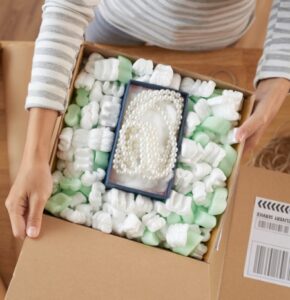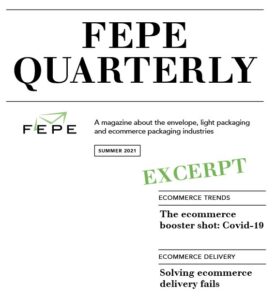Background: The shift towards ecommerce
The past years have seen a fast and steady shift from in-store to online retail trading. The Covid-19 pandemic massively accelerated the trend: online orders reached record levels in 2020.
Retail analysts unanimously predict that the shift towards e-commerce is definitive. While there will inevitably be variations in the share of ecommerce in total retail, overall the share has grown significantly and permanently. Once customers get used to the convenience of shopping online, and overcome any residual mistrust of ecommerce, they develop new habits that persist.
The shift is global. The greatest increase in shopping online happened in countries that had comparatively lower levels of ecommerce pre-covid. Millions of consumers who till now had shied away from ecommerce – whether because of their age, their digital competence or simply their personal preference for in-store shopping – have had to learn to adapt. Few will revert completely to how they shopped before.
Another factor driving the increase in ecommerce is that the retail offer has improved. Retailers that had little interest in building an ecommerce offer (with an appropriate webshop, delivery and after-sales service) pre-Covid were forced to set it up when their stores had to be closed. With the investment made and customers using it, it would make little sense for them to close it down again.
See also: Macrotrends
Packaging needs to catch up!

The more people use ecommerce, the more they expand the range of items that they are willing to buy online. The more retailers build an ecommerce offer with cheap delivery, even for individual small items, the more customers will order them.
Up to now, the packaging industry has struggled to keep up with ecommerce. Retailers are using standard-sized cardboard boxes that are often grossly oversized for the items shipped in them. Delivery trucks the world over are filled with big cardboard boxes containing one or two small items immersed in filler; polystyrene beads, air-filled plastic pouches, bubble wrap, and shredded, crinkled or scrunched brown paper filler.
What a waste!
Opportunities for the envelope industry
Retailers don’t want to waste their money on [over-]packaging. Delivery companies don’t want to transport air and customers want packages that fit in their mailbox.
The market is ripe for the introduction of a range of efficient, versatile, sustainable packaging for ecommerce deliveries.
Lightweight, non-bulky items often don’t need to be sent in a cardboard box. (Often, they are already in appropriate packaging.) They can be sent in envelopes instead.
FEPE members are already producing a wide range of envelopes and pouches that are eminently suitable for ecommerce deliveries. They are also exploring the possibilities for even more sustainable and efficient solutions, such as all-paper cushioned envelopes in different formats.
Benefits of ecommerce envelopes
Sending ecommerce deliveries in envelopes has major benefits for retailers, delivery companies and customers – and the environment.
- Lower cost for the retailer: one envelope is cheaper to stock, handle and deliver than a larger box with filling.
- Efficient use of resources: the smaller the delivery package, the lower the environmental and monetary cost of its production, transport and recycling.
- Improved logistics efficiency: more items per truckload.
- The delivery can fit in a mailbox, so the customer doesn’t have to be at home to receive it.
Resources
FEPE Quarterly magazine Issue 2 (Summer 2021) – Ecommerce excerpts. Two articles on the rise of ecommerce and ecommerce deliveries.
2018 FEPE report – Opportunities for the European Envelope Industry – Research on current packaging preferences for online shipments, and obstacles and opportunities for the envelope industry.
Contact: secretariat@fepe.org to request a copy.

